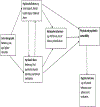Physical and psychiatric comorbidities among patients with severe mental illness as seen in Uganda
- PMID: 36002543
- PMCID: PMC9950291
- DOI: 10.1007/s00406-022-01478-6
Physical and psychiatric comorbidities among patients with severe mental illness as seen in Uganda
Abstract
While psychiatric and physical comorbidities in severe mental illness (SMI) have been associated with increased mortality and poor clinical outcomes, problem has received little attention in low- and middle-income countries (LMICs). This study established the prevalence of psychiatric (schizophrenia, bipolar affective disorder, and recurrent major depressive disorder) and physical (HIV/AIDS, syphilis, hypertension and obesity) comorbidities and associated factors among 1201 out-patients with SMI (schizophrenia, depression and bipolar affective disorder) attending care at two hospitals in Uganda. Participants completed an assessment battery including structured, standardised and locally translated instruments. SMIs were established using the MINI International Neuropsychiatric Interview version 7.2. We used logistic regression to determine the association between physical and psychiatric comorbidities and potential risk factors. Bipolar affective disorder was the most prevalent (66.4%) psychiatric diagnoses followed by schizophrenia (26.6%) and recurrent major depressive disorder (7.0%). Prevalence of psychiatric comorbidity was 9.1%, while physical disorder comorbidity was 42.6%. Specific comorbid physical disorders were hypertension (27.1%), obesity (13.8%), HIV/AIDS (8.2%) and syphilis (4.8%). Potentially modifiable factors independently significantly associated with psychiatric and physical comorbidities were: use of alcohol for both syphilis and hypertension comorbidities; and use of a mood stabilisers and khat in comorbidity with obesity. Only psychiatric comorbidity was positively associated with the negative outcomes of suicidality and risky sexual behaviour. The healthcare models for psychiatric care in LMICs such as Uganda should be optimised to address the high burden of psychiatric and physical comorbidities.
Keywords: Association; Healthcare models; Physical and psychiatric comorbidities; Potential risk factors.
© 2022. The Author(s), under exclusive licence to Springer-Verlag GmbH Germany.
Conflict of interest statement
Figures
Similar articles
-
Post-traumatic stress disorder, psychiatric comorbidities and associated factors among refugees in Nakivale camp in southwestern Uganda.BMC Psychiatry. 2020 Feb 7;20(1):53. doi: 10.1186/s12888-020-2480-1. BMC Psychiatry. 2020. PMID: 32033558 Free PMC article.
-
Prevalence of Severe Mental Illness and Its Associations With Health Outcomes in Patients With CKD: A Swedish Nationwide Study.Am J Kidney Dis. 2025 May;85(5):577-588.e1. doi: 10.1053/j.ajkd.2024.12.004. Epub 2025 Feb 25. Am J Kidney Dis. 2025. PMID: 40010484
-
[Drawing up guidelines for the attendance of physical health of patients with severe mental illness].Encephale. 2009 Sep;35(4):330-9. doi: 10.1016/j.encep.2008.10.014. Epub 2009 Jul 9. Encephale. 2009. PMID: 19748369 French.
-
Psychiatric and medical comorbidities of bipolar disorder.Psychosom Med. 2005 Jan-Feb;67(1):1-8. doi: 10.1097/01.psy.0000151489.36347.18. Psychosom Med. 2005. PMID: 15673617 Review.
-
Systematic Literature Review of Psychiatric Comorbidities in Adults with Epilepsy.J Clin Neurol. 2021 Apr;17(2):176-186. doi: 10.3988/jcn.2021.17.2.176. J Clin Neurol. 2021. PMID: 33835737 Free PMC article. Review.
Cited by
-
Physical and sexual victimization of persons with severe mental illness seeking care in central and southwestern Uganda.Front Public Health. 2023 Aug 9;11:1167076. doi: 10.3389/fpubh.2023.1167076. eCollection 2023. Front Public Health. 2023. PMID: 37621606 Free PMC article.
-
Coping strategies, challenges and potential interventions among adult patients with HIV and mental illness comorbidity in southwestern Uganda.Glob Public Health. 2024 Jan;19(1):2372802. doi: 10.1080/17441692.2024.2372802. Epub 2024 Jul 11. Glob Public Health. 2024. PMID: 38989538 Free PMC article.
-
Physical activity counselling in women with HIV/AIDS and suicidal ideation: a secondary analysis of a real-world intervention in Ugandan HIV counselling centres.Pan Afr Med J. 2023 May 31;45:70. doi: 10.11604/pamj.2023.45.70.40093. eCollection 2023. Pan Afr Med J. 2023. PMID: 37637405 Free PMC article.
-
Victimisation in the life of persons with severe mental illness in Uganda: a pluralistic qualitative study.BMC Psychiatry. 2024 Apr 30;24(1):329. doi: 10.1186/s12888-024-05720-4. BMC Psychiatry. 2024. PMID: 38689240 Free PMC article.
-
Sexual and reproductive health needs of women with severe mental illness in low- and middle-income countries: A scoping review.PLoS One. 2025 Jan 16;20(1):e0311554. doi: 10.1371/journal.pone.0311554. eCollection 2025. PLoS One. 2025. PMID: 39820210 Free PMC article.
References
-
- World Health Organization. Addressing comorbidity between mental disorders and major noncommunicable diseases. Background technical report to support implementation of the WHO European Mental Health Action Plan 2013–2020 and the WHO European Action Plan for the Prevention and Control of Non-communicable Diseases 2016–2025. UN City, Marmorvej 51DK-2100 Copenhagen Ø, Denmark: WHO Regional Office for Europe; 2017
-
- Richter D, Wall A, Bruen A, Whittington R (2019) Is the global prevalence rate of adult mental illness increasing? Systematic review and meta-analysis. Acta Psychiatr Scand 140(5):393–407 - PubMed
-
- Häfner H (1985) Are mental disorders increasing over time? Psychopathology 18(2–3):66–81 - PubMed
-
- Twenge JM, Cooper AB, Joiner TE, Duffy ME, Binau SG (2019) Age, period, and cohort trends in mood disorder indicators and suicide-related outcomes in a nationally representative dataset, 2005–2017. J Abnorm Psychol 128(3):185–199 - PubMed
MeSH terms
Grants and funding
LinkOut - more resources
Full Text Sources
Medical


